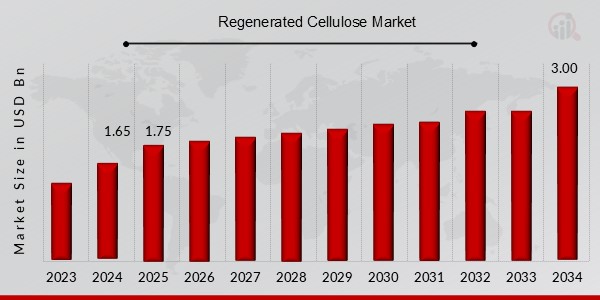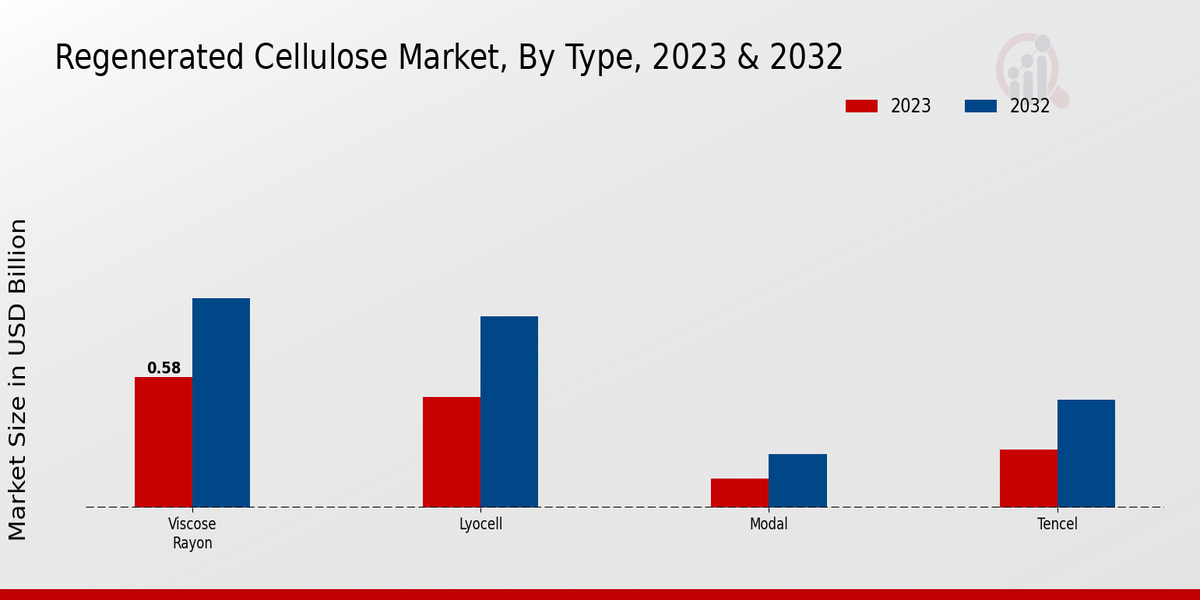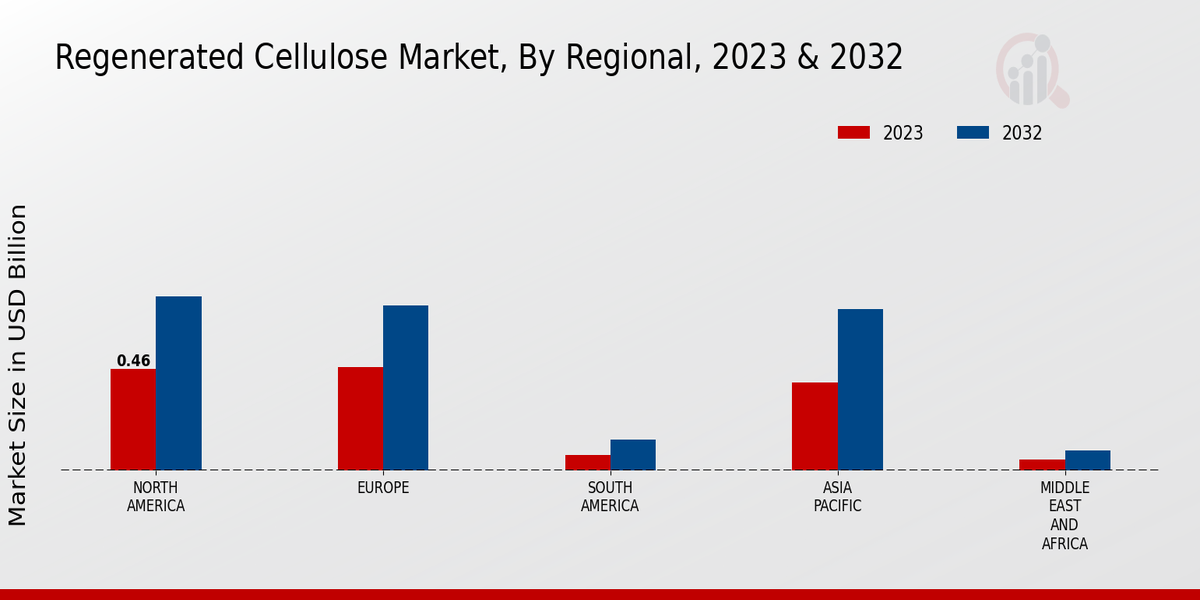Global Regenerated Cellulose Market Overview
The Regenerated Cellulose Market Size was estimated at 1.65 (USD Billion) in 2024. The Regenerated Cellulose Industry is expected to grow from 1.75 (USD Billion) in 2025 to 3 (USD Billion) by 2034. The Regenerated Cellulose Market CAGR (growth rate) is expected to be around 6.20% during the forecast period (2025 - 2034).
Key Regenerated Cellulose Market Trends Highlighted
Key market drivers fueling the growth of the regenerated cellulose market include the growing demand for sustainable and biodegradable materials, the increasing popularity of plant-based products, and the stringent regulations on the use of synthetic materials. Opportunities for growth lie in the development of innovative applications, such as biodegradable food packaging, textiles, and medical products.
Recent trends in the market include the adoption of bio-based and compostable materials, the integration of advanced technologies for improved performance, and the shift towards a circular economy. Key players are focusing on research and development to enhance the functionality and sustainability of regenerated cellulose products. Innovations in production processes and the use of renewable feedstocks are expected to drive the market's growth in the coming years.

Source: Primary Research, Secondary Research, Market Research Future Database and Analyst Review
Regenerated Cellulose Market Drivers
-
Growing Demand for Sustainable and Eco-Friendly Materials
The increasing awareness of the environmental impact of traditional materials has led to a growing demand for sustainable and eco-friendly alternatives. Regenerated cellulose, which is derived from plant-based materials, offers a sustainable and biodegradable option for a wide range of applications. This growing demand for sustainable materials is expected to drive the growth of the Regenerated Cellulose Market Industry in the coming years.
Expanding Applications in Various Industries
Regenerated cellulose has a wide range of applications across various industries, including textiles, packaging, and medical. The unique properties of regenerated cellulose, such as its strength, biodegradability, and moisture-wicking capabilities, make it a suitable material for a variety of applications. The expanding applications of regenerated cellulose in various industries are expected to contribute to the growth of the Regenerated Cellulose Market Industry.
Technological Advancements and Innovations
The Regenerated Cellulose Market Industry is witnessing continuous technological advancements and innovations. These advancements are focused on improving the production efficiency, reducing the environmental impact, and enhancing the performance of regenerated cellulose. For instance, the development of new production technologies, such as ionic liquids-based processes, has enabled the production of regenerated cellulose with improved properties and reduced environmental impact. These technological advancements are expected to drive the growth of the Regenerated Cellulose Market Industry.
Regenerated Cellulose Market Segment Insights
Regenerated Cellulose Market Type Insights
The Regenerated Cellulose Market is segmented by Type taking into consideration Viscose Rayon, Lyocell, Modal, Tencel, and Others. Viscose Rayon occupied the highest market share of the Regenerated Cellulose Market in 2023 and will continue to be the market leader during the forecast period. The dominance of this segment is attributed to its bulk application in all the end-user industries, such as textiles, automotive, and packaging.
The Lyocell segment is expected to witness a higher growth rate during the forecast period mainly because it is considered to be a more sustainable version of Viscose Rayon with a higher growth potential due to an increased demand for eco-friendly products.Modal is another type of regenerated cellulose with superior softness and moisture-wicking properties compared to Viscose Rayon. The increasing demand for comfortable and breathable fabric assuring the feeling of luxury and softness has substantially increased the demand for Modal. Tencel is one of the major brands of Lyocell and it is considered as the strongest of all regenerated cellulose.
The demand for Tencel is getting increased in the market due to its higher strength, resistance to wrinkles, and biodegradability. Other types of regenerated cellulose include cellulose acetate and cupro. These types are further divided into different subtypes based on the production and processing techniques.
Despite the higher application in the textile sector, synthetic fibers are expected to retain a moderate growth rate compared to other types during the forecast period. Many drivers of this market, such as the demand for sustainable and eco-friendly materials and an increasing number of people getting to know the disadvantages of synthetic fiber, will help the market grow.

Source: Primary Research, Secondary Research, Market Research Future Database and Analyst Review
Regenerated Cellulose Market Application Insights
The Clothing segment dominated the market owing to the rising demand for eco-friendly clothing. The Home Textiles segment is expected to be the fastest growing segment over the forecast period due to increasing consumer preference for sustainable home décor. The Medical segment is estimated to be a lucrative segment owing to the increasing use of regenerated cellulose in wound dressings and medical devices. The Industrial segment is estimated to have steady growth due to increasing use of regenerated cellulose in packaging and other industrial applications.
The Other segment includes personal care and automotive applications, which are estimated to contribute to the overall market growth.
Regenerated Cellulose Market Fiber Form Insights
The Regenerated Cellulose Market segmentation by Fiber Form includes Staple Fiber, Filament, Spun Yarn, Woven Fabric, and Knitted Fabric. In 2023, the Staple Fiber segment held the largest market share of around 40%, and it is projected to maintain its dominance throughout the forecast period. This growth is attributed to its extensive usage in the textile industry for producing a wide range of fabrics, including apparel, home furnishings, and industrial textiles.
The Woven Fabric segment is expected to witness significant growth during the forecast period due to its increasing demand in the automotive and construction industries.The Knitted Fabric segment is also anticipated to grow steadily, driven by its rising popularity in the sportswear and athleisure markets. Overall, the Regenerated Cellulose Market is expected to continue to grow in the coming years, with the increasing demand for sustainable and eco-friendly materials in various industries.
Regenerated Cellulose Market End-Use Industry Insights
The regenerated cellulose market is segmented based on end-use industry into textiles, apparel, medical, automotive, and others. Among these segments, the textiles and apparel segment are expected to account for the largest share of the overall market in 2023 and is projected to continue its dominance throughout the forecast period.
The medical segment is also expected to witness significant growth due to the increasing demand for regenerated cellulose-based wound care products and medical devices. The automotive segment is anticipated to grow steadily, driven by the rising adoption of regenerated cellulose in vehicle interiors and components due to its eco-friendly and lightweight properties.Furthermore, the other segment, which includes applications such as packaging, electronics, and personal care, is expected to exhibit moderate growth over the forecast period.
Regenerated Cellulose Market Regional Insights
The Regenerated Cellulose Market is segmented into several regions, including North America, Europe, APAC, South America, and MEA. Among these regions, North America held a significant market share in 2023 and is projected to continue its dominance throughout the forecast period. The growth in this region is primarily attributed to the increasing demand for regenerated cellulose fibers in the textile industry, particularly in the production of sustainable and eco-friendly clothing.
Europe is another key region in the Regenerated Cellulose Market, with a substantial market share. The growing demand for regenerated cellulose in the automotive industry, particularly in the manufacturing of lightweight and fuel-efficient vehicles, is driving the market growth in this region. APAC is expected to witness the highest growth rate during the forecast period due to the rising demand for regenerated cellulose in various applications, such as packaging, construction, and consumer goods. The increasing awareness of environmental sustainability and the growing adoption of bio-based materials in these industries are contributing to the growth of the APAC Regenerated Cellulose Market.
 Source: Primary Research, Secondary Research, MRFR Database and Analyst Review
Source: Primary Research, Secondary Research, MRFR Database and Analyst Review
Regenerated Cellulose Market Key Players And Competitive Insights
Major players in Regenerated Cellulose Market industry are focusing on expanding their presence along with increasing their production capacities to meet the growing demand. Additionally, Leading Regenerated Cellulose Market players are actively involved in research and development to introduce innovative products and applications. Partnerships, joint ventures, and collaborations are common strategies adopted by companies to strengthen their market position. These initiatives are expected to drive the Regenerated Cellulose Market development and intensify the competitive landscape. The market is expected to witness the emergence of new players, as well as the expansion of existing companies' product portfolios.
Technological advancements and increasing investments in research and development are anticipated to shape the future of Regenerated Cellulose Market industry.Lenzing AG, a leading player in the Regenerated Cellulose Market, is committed to sustainable production and offers a wide range of regenerated cellulose fibers. The company has a strong presence in key markets and is continuously investing in capacity expansions to meet the growing demand for its products. Lenzing AG's focus on sustainability and innovation has helped it maintain its position as a frontrunner in the industry.
The company's commitment to environmental stewardship and transparency in its supply chain has made it a preferred choice for consumers seeking eco-friendly products.Saitex, another prominent competitor in the Regenerated Cellulose Market, is known for its high-quality viscose fibers. The company has a presence and caters to a diverse customer base. Saitex's commitment to innovation has led to the development of specialty fibers for specific applications, such as medical textiles and nonwovens. The company's strong distribution network and focus on customer service have contributed to its success in various markets.
Saitex's emphasis on sustainability and responsible manufacturing practices has also resonated with consumers, enhancing its reputation in the industry.
Key Companies in the Regenerated Cellulose Market Include
Regenerated Cellulose Market Industry Developments
-
Q2 2024: Lenzing Group opens new lyocell plant in Thailand Lenzing Group inaugurated its new state-of-the-art lyocell production facility in Prachinburi, Thailand, expanding its global capacity for sustainable regenerated cellulose fibers.
-
Q1 2024: Grasim Industries appoints new CEO for Birla Cellulose Grasim Industries announced the appointment of a new Chief Executive Officer for its Birla Cellulose division, which is a major producer of regenerated cellulose fibers.
-
Q2 2024: Kelheim Fibres and Sappi announce partnership for sustainable fiber innovation Kelheim Fibres entered into a partnership with Sappi to jointly develop new sustainable regenerated cellulose fiber products for hygiene and specialty applications.
-
Q2 2024: Lenzing and Orange Fiber launch new TENCEL™ Limited Edition made of citrus pulp Lenzing Group and Orange Fiber launched a limited edition of TENCEL™ branded lyocell fibers made from orange pulp, marking a new product innovation in regenerated cellulose.
-
Q1 2024: Sateri commissions new viscose staple fiber production line in China Sateri, a leading producer of regenerated cellulose, commissioned a new viscose staple fiber production line at its facility in Jiangxi, China, increasing its annual capacity.
-
Q2 2024: Lenzing Group and Renewcell sign multi-year pulp supply agreement Lenzing Group signed a multi-year agreement with Renewcell to source Circulose® pulp, supporting the production of regenerated cellulose fibers from recycled textiles.
-
Q1 2024: Indorama Ventures completes acquisition of Dezhou Huayuan Eco-Technology Indorama Ventures completed the acquisition of Dezhou Huayuan Eco-Technology, a Chinese manufacturer of regenerated cellulose fibers, expanding its presence in the sustainable fiber market.
-
Q2 2024: Lenzing Group launches carbon-zero TENCEL™ fibers for nonwovens Lenzing Group introduced a new range of carbon-zero TENCEL™ branded lyocell fibers for nonwoven applications, targeting hygiene and personal care markets.
-
Q1 2024: Sateri and China National Textile and Apparel Council sign MoU for green development Sateri signed a Memorandum of Understanding with the China National Textile and Apparel Council to promote green development and sustainable practices in the regenerated cellulose sector.
-
Q2 2024: Kelheim Fibres receives certification for biodegradable specialty fibers Kelheim Fibres announced it received certification for its specialty regenerated cellulose fibers, confirming their biodegradability in marine and soil environments.
-
Q1 2024: Lenzing Group secures €200 million green financing for cellulose fiber expansion Lenzing Group secured €200 million in green financing to support the expansion of its sustainable regenerated cellulose fiber production capacity.
-
Q2 2024: Grasim Industries announces new viscose fiber plant in Gujarat Grasim Industries announced plans to build a new viscose fiber plant in Gujarat, India, to increase its production of regenerated cellulose fibers.
Regenerated Cellulose Market Segmentation Insights
Regenerated Cellulose Market Type Outlook
Regenerated Cellulose Market Application Outlook
Regenerated Cellulose Market Fiber Form Outlook
Regenerated Cellulose Market End-Use Industry Outlook
Regenerated Cellulose Market Regional Outlook
| Report Attribute/Metric |
Details |
| Market Size 2024 |
1.65 (USD Billion) |
| Market Size 2025 |
1.75 (USD Billion) |
| Market Size 2034 |
3 (USD Billion) |
| Compound Annual Growth Rate (CAGR) |
6.20% (2025 - 2034) |
| Report Coverage |
Revenue Forecast, Competitive Landscape, Growth Factors, and Trends |
| Base Year |
2024 |
| Market Forecast Period |
2025 - 2034 |
| Historical Data |
2020 - 2024 |
| Market Forecast Units |
USD Billion |
| Key Companies Profiled |
Birla Cellulose, Grasim Industries, CVL Rayon, Domtar Corporation, Fulida Textile Group, Eastman Chemical Company, Hyosung Corporation, Sateri Holding Group, Kelheim Fibres, Indorama Ventures, Nanjing Chemical Fiber, Thai Rayon, TENCEL, Lenzing AG |
| Segments Covered |
Type, Application, Fiber Form, End-Use Industry, Regional |
| Key Market Opportunities |
1 Growing demand for sustainable textiles2 Increasing consumer preference for natural and biodegradable materials3 Expansion of applications in medical and healthcare industries4 Government initiatives to promote circular economy and reduce plastic waste |
| Key Market Dynamics |
Inflation Sustainability Concerns Textile Industry Growth Technological Innovations Growing Consumer Awareness |
| Countries Covered |
North America, Europe, APAC, South America, MEA |
Frequently Asked Questions (FAQ):
The Regenerated Cellulose Market is anticipated to reach USD 1.75 Billion in 2025.
The Regenerated Cellulose Market is projected to grow at a CAGR of 6.20% from 2025 to 2034.
The Regenerated Cellulose Market is estimated to reach USD 3 Billion by 2034.
North America is expected to hold the largest market share in the Regenerated Cellulose Market.
The textile industry is expected to hold the largest market share in the Regenerated Cellulose Market.
Some of the key competitors in the Regenerated Cellulose Market include Lenzing AG, Sateri Holdings, and Kelheim Fibres GmbH.
Rising demand for sustainable and biodegradable materials, growing awareness about environmental concerns, and increasing adoption of regenerated cellulose in various industries are driving the growth of the Regenerated Cellulose Market
Fluctuating prices of raw materials, intense competition, and limited availability of sustainably sourced wood pulp are some of the challenges faced by the Regenerated Cellulose Market.
Growing demand for eco-friendly products, increasing adoption of regenerated cellulose in emerging markets, and technological advancements in the production of regenerated cellulose present opportunities for growth in the Regenerated Cellulose Market.
Government regulations aimed at promoting sustainability and reducing environmental impact are expected to have a positive impact on the Regenerated Cellulose Market.







 Source: Primary Research, Secondary Research, MRFR Database and Analyst Review
Source: Primary Research, Secondary Research, MRFR Database and Analyst Review







